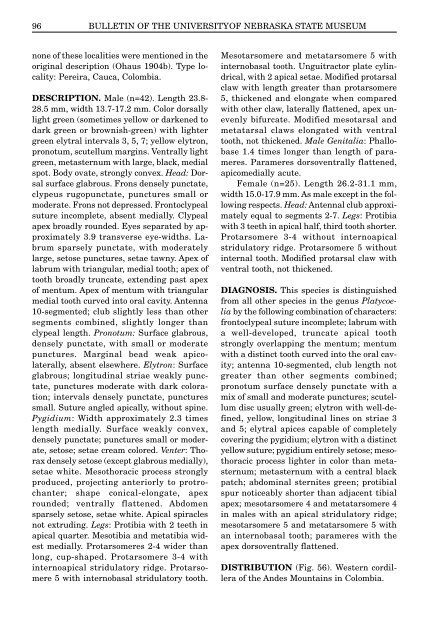Download full text (PDF 4.5 MB) - University of Nebraska State ...
Download full text (PDF 4.5 MB) - University of Nebraska State ...
Download full text (PDF 4.5 MB) - University of Nebraska State ...
You also want an ePaper? Increase the reach of your titles
YUMPU automatically turns print PDFs into web optimized ePapers that Google loves.
96 BULLETIN OF THE UNIVERSITYOF NEBRASKA STATE MUSEUM<br />
none <strong>of</strong> these localities were mentioned in the<br />
original description (Ohaus 1904b). Type locality:<br />
Pereira, Cauca, Colombia.<br />
DESCRIPTION. Male (n=42). Length 23.8-<br />
28.5 mm, width 13.7-17.2 mm. Color dorsally<br />
light green (sometimes yellow or darkened to<br />
dark green or brownish-green) with lighter<br />
green elytral intervals 3, 5, 7; yellow elytron,<br />
pronotum, scutellum margins. Ventrally light<br />
green, metasternum with large, black, medial<br />
spot. Body ovate, strongly convex. Head: Dorsal<br />
surface glabrous. Frons densely punctate,<br />
clypeus rugopunctate, punctures small or<br />
moderate. Frons not depressed. Frontoclypeal<br />
suture incomplete, absent medially. Clypeal<br />
apex broadly rounded. Eyes separated by approximately<br />
3.9 transverse eye-widths. Labrum<br />
sparsely punctate, with moderately<br />
large, setose punctures, setae tawny. Apex <strong>of</strong><br />
labrum with triangular, medial tooth; apex <strong>of</strong><br />
tooth broadly truncate, extending past apex<br />
<strong>of</strong> mentum. Apex <strong>of</strong> mentum with triangular<br />
medial tooth curved into oral cavity. Antenna<br />
10-segmented; club slightly less than other<br />
segments combined, slightly longer than<br />
clypeal length. Pronotum: Surface glabrous,<br />
densely punctate, with small or moderate<br />
punctures. Marginal bead weak apicolaterally,<br />
absent elsewhere. Elytron: Surface<br />
glabrous; longitudinal striae weakly punctate,<br />
punctures moderate with dark coloration;<br />
intervals densely punctate, punctures<br />
small. Suture angled apically, without spine.<br />
Pygidium: Width approximately 2.3 times<br />
length medially. Surface weakly convex,<br />
densely punctate; punctures small or moderate,<br />
setose; setae cream colored. Venter: Thorax<br />
densely setose (except glabrous medially),<br />
setae white. Mesothoracic process strongly<br />
produced, projecting anteriorly to protrochanter;<br />
shape conical-elongate, apex<br />
rounded; ventrally flattened. Abdomen<br />
sparsely setose, setae white. Apical spiracles<br />
not extruding. Legs: Protibia with 2 teeth in<br />
apical quarter. Mesotibia and metatibia widest<br />
medially. Protarsomeres 2-4 wider than<br />
long, cup-shaped. Protarsomere 3-4 with<br />
internoapical stridulatory ridge. Protarsomere<br />
5 with internobasal stridulatory tooth.<br />
Mesotarsomere and metatarsomere 5 with<br />
internobasal tooth. Unguitractor plate cylindrical,<br />
with 2 apical setae. Modified protarsal<br />
claw with length greater than protarsomere<br />
5, thickened and elongate when compared<br />
with other claw, laterally flattened, apex unevenly<br />
bifurcate. Modified mesotarsal and<br />
metatarsal claws elongated with ventral<br />
tooth, not thickened. Male Genitalia: Phallobase<br />
1.4 times longer than length <strong>of</strong> parameres.<br />
Parameres dorsoventrally flattened,<br />
apicomedially acute.<br />
Female (n=25). Length 26.2-31.1 mm,<br />
width 15.0-17.9 mm. As male except in the following<br />
respects. Head: Antennal club approximately<br />
equal to segments 2-7. Legs: Protibia<br />
with 3 teeth in apical half, third tooth shorter.<br />
Protarsomere 3-4 without internoapical<br />
stridulatory ridge. Protarsomere 5 without<br />
internal tooth. Modified protarsal claw with<br />
ventral tooth, not thickened.<br />
DIAGNOSIS. This species is distinguished<br />
from all other species in the genus Platycoelia<br />
by the following combination <strong>of</strong> characters:<br />
frontoclypeal suture incomplete; labrum with<br />
a well-developed, truncate apical tooth<br />
strongly overlapping the mentum; mentum<br />
with a distinct tooth curved into the oral cavity;<br />
antenna 10-segmented, club length not<br />
greater than other segments combined;<br />
pronotum surface densely punctate with a<br />
mix <strong>of</strong> small and moderate punctures; scutellum<br />
disc usually green; elytron with well-defined,<br />
yellow, longitudinal lines on striae 3<br />
and 5; elytral apices capable <strong>of</strong> completely<br />
covering the pygidium; elytron with a distinct<br />
yellow suture; pygidium entirely setose; mesothoracic<br />
process lighter in color than metasternum;<br />
metasternum with a central black<br />
patch; abdominal sternites green; protibial<br />
spur noticeably shorter than adjacent tibial<br />
apex; mesotarsomere 4 and metatarsomere 4<br />
in males with an apical stridulatory ridge;<br />
mesotarsomere 5 and metatarsomere 5 with<br />
an internobasal tooth; parameres with the<br />
apex dorsoventrally flattened.<br />
DISTRIBUTION (Fig. 56). Western cordillera<br />
<strong>of</strong> the Andes Mountains in Colombia.
















